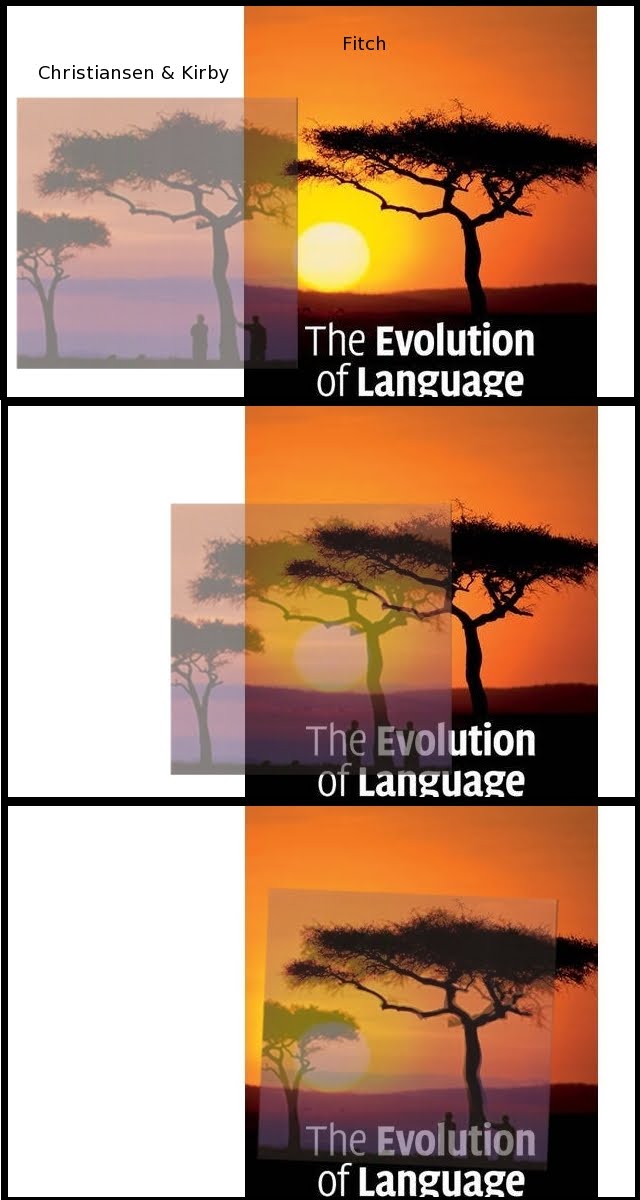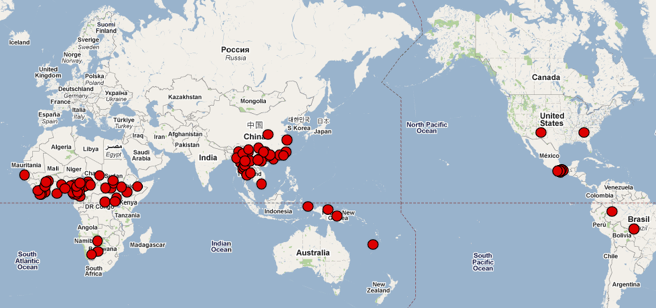A while ago, some collegues and I noticed that two prominent books on Language Evolution -Christiansen & Kirby’s Language Evolution and Fitch’s Evolution of Language – both included a picture of an acacia tree in the sunset on their covers. On closer analysis, it turned out that they were the same tree:
Thus began the Acacia Tree Hypothesis of Language Evolution.
Following this up, I was thinking about Dediu & Ladd’s discovery that linguistic tone is has certain genetic correlates. Here’s the map of languages with linguistic tone:
However, I suspected the devious influence of acacia trees and so I found some information on their geographic distribution:
As I suspected, countries in which the acacia tree Acacia nilotica grows are significantly more likely to have tonal languages:
| Tone | No Tone | |
| Acacia Trees | 163 | 117 |
| No Acacia Trees | 104 | 237 |
(Chi-squared with Yates’ continuity correction = 47.1, df = 1, p < 0.0001, data from Crop Protection Consortium and the World Atlas of Language Structures).
The plot thickens …
Dediu, D., & Ladd, D. R. (2007). Linguistic tone is related to the population frequency of the adaptive haplogroups of two brain size genes, Microcephalin and ASPM. Proceedings of the National Academy of Sciences, 104, 10944–10949.
Fitch, W. T. 2010 The evolution of language. Cambridge, UK: Cambridge University Press.
Christiansen, M. and Kirby, S. (2003). Language Evolution. Oxford University Press.
Update:
I’ve added the images David mentioned to the post:


 Also, The Babel’s Dawn blog banner
Also, The Babel’s Dawn blog banner




Why does this remind me of the Atkinson paper?
It’s not only those two publications that are related to language evolution (or at least evolutionary psychology and human cognitive evolution) and which use an acacia silhouette:
http://www.amazon.co.uk/Original-Signs-Gesture-Sources-Language/dp/1563680750/ref=wl_it_dp_o?ie=UTF8&coliid=I12NVLXMDO4B67&colid=4Y8ZKICVSG1C
http://www.amazon.co.uk/Moral-Psychology-vol-Neuroscience-Development/dp/0262693550/ref=wl_it_dp_o?ie=UTF8&coliid=I3VCBD00P44KIL&colid=38VMCO9H2250J
http://www.amazon.co.uk/Before-Dawn-Recovering-History-Ancestors/dp/0715636588/ref=wl_it_dp_o?ie=UTF8&coliid=I3L2I8H326USPS&colid=4Y8ZKICVSG1C
On closer inspection, not all of the above titles may show acacia trees, but there is a trend for very similar looking trees to be silhouetted against a red/yellow sunset (or sunrise).
Haha, very astute. You’re building up quite a body of work Sean: siestas and alcohol affecting morphological complexity, the acacia tree hypothesis of language evolution… What’s next? Maybe your next game-changing paper should investigate whether the level of clausal embedding in a language is contingent on number of Matryoshka doll manufacturers…? Just a thought 😉
This is, of course, just a demonstration of the risk of spurious correlations in large data sets. Although there’s something in that doll idea …
But there does seem to be a neat correlation of linguistic tone with geographical latitude. Any explanations for that, e.g. Daniel-Nettle-style?
Daniel 🙂
I did a tineye search on both covers, and only turned up (2) non-book results for Fitch’s cover. That picture occurred in two versions on gettyimages which are down now, but there’s plenty more in a similar style if you search for ‘acacia’.
http://www.gettyimages.com/detail/103580228/
http://www.gettyimages.com/detail/56947083/
http://www.gettyimages.com/detail/AB11443/
As I mentioned here, both images are from CORBIS, and they’re both shot in Massai Mara game reserve in Kenya.